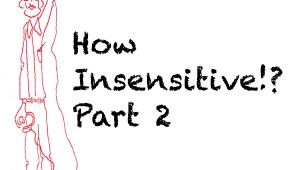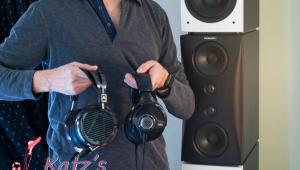| Columns Retired Columns & Blogs |
Katz's Corner: The Great Headphone Shootout - Part 3

This story originally appeared at InnerFidelity.com
On Friday, three days before the Headphone Slutz group meeting, I received my demo headphones from the Cable Company. The Xs and the 3s they sent are in mint condition, in perfect physical shape. The demo 3s are the newest model with Fazors and the Xs have always been equipped with Fazors. Then I dropped in at Charlie's to borrow his LCD-2s (new models with Fazors) and his Schiit Magni headphone amp, so I could set up all the connections. I use Mogami AES cable exclusively for all analog and digital interconnects in my studio. Mogami cable is very well made with oxygen-free copper, which enhances conductivity. I've found that Mogami AES cable used for analog interconnect not only has a very high bandwidth due to its low capacitance, it also sounds completely neutral. In contrast, I've found many other so-called "audiophile" cables have a resonance, sometimes a rise at high frequencies that sounds peaky, unpleasant or artificial, and they are not tonally neutral. A high frequency rise can give the artificial impression of detail, but it could represent distortion or impedance interaction that is not accurate. For me, accuracy has to come first—after that, the rest is a bonus!
I built some analog Y-cables so I could feed the Benchmark DAC into the Burson and the KGSS (Stax) amp. The Prism fed another input of the Burson and Stax as well as the Schiit amp. The Prism operated on internal clock with its asynchronous USB connection, which is a potential advantage over the Benchmark, which received signal via SPDIF from the Prism's digital out. I have confidence that Prism's digital output has been dejittered and is the same performance as the signal going in. The output levels of both DACs were matched to less than 0.1 dB with a 1 kHz sine wave. Five listeners at once could now audition cans, from the Burson, Schiit, Benchmark, Stax and Prism headphone outputs. In addition to the three Audeze cans and the Stax, a set of Sennheiser HD600s (which many were familiar with) and Sennheiser HD280 Pros were available as a "reality check". Aaron also tried his faithful Ultrasones but I think he was soon depressed.

Here is a photo of the four king headphones at the session, ready to rumble.
Bob's First Listen
Between Friday and Monday, before the group arrived, I spent hours comparing the premium headphones. Here are my notes:
The Amp Choice
I found the Burson amplifier to be warmer (in a nice way, without losing any detail), more robust and full-bodied than the Schiit Magni. The Burson also throws a wider image. The difference is not subtle, but keep in mind the Schiit goes for $99 versus $999 for the Burson, making the Schiit one of the the best bargain headphone amplifiers made. If I had a more limited budget I would not hesitate to buy the Schiit Magni. And Schiit has just dropped the price of the original Magni to $79, so get them while you can!
I feel that the Burson has all the sonic virtues of tubes without tubes and without any of the flabby bottom end issues exhibited by so many tube amps with poor power supply design. It's tight, powerful, warm (but detailed), big, bold and beautiful. I find that good Class A solid-state circuits like the Burson have a lot in common with the sound quality of good tube amp designs. It runs quite warm and in that and all other respects it reminds me of the lovely Class A Krell KSA-100 I had for several years. I do like "neutral" but I don't like "cold" or harsh: I want the sound to draw the listener in, not drive him away. So if an amp is delicately on the warm side of neutral and has good detail and depth I'll be perfectly happy. So I did the rest of my dynamic headphone auditioning on the Burson, which turned out to be my favorite amp among the 4 dynamic amps.
The DAC Choice
The Benchmark DAC-1 is far from the current model, and I wouldn't be surprised to find the DAC-2 sounds even better, but anyway, the Prism beat out the DAC-1 by a few inches: it produces a bit of a deeper image and wider soundstage. This would be more obvious on loudspeakers, which reveal depth differences more readily than headphones. Tonally the two DACs sound very similar, with the Prism having a bit more detail and definition. So I limited my listening to the Prism, the Burson and the Stax amp.
The Audeze Differences
Switching between headphones initially proved a shocking experience. At first the differences are so dramatic, especially between the electrostatic and the planar, until you acclimate within a minute. It's amazing to observe that there are so many "audiophile-quality" playback systems, yet they all sound different! With good headphones like these, however, differences can melt away and turn into simple, pleasurable listening.
But I plowed on, because my job was to pick a winner, and my profession is to make 0.1 dB decisions and to discern small differences. That's my job, mastering engineer. But the great thing is that all four of these great headphones made it very easy to forget their differences and just get involved in the music. That's the real news about this shootout. As one participant remarked, "I wouldn't kick any of these four out of bed."
The LCD-3s are about $250 more expensive than the Xs (such a nice pet name for a headphone), at $1945 versus $1699, so they must be the better cans, right? That was not my experience. However, the 3s are definitely lighter and more comfortable than the X's. My wife feels the X's are very heavy and "clamp on her head"; she's not comfortable with the physical experience, and definitely prefers the Stax—which almost float in the air and you are almost unconscious of their physical presence.
But in the interest of good sound, the weight issue becomes necessary to tolerate. In fact, the reason an Audeze phone sounds so good is tied to its weight, size, and heavy magnet structure. For me, the bottom end and lower midrange of the 3s sounds very seductive, warm, clear and punchy, but objectively, tonally they are not as accurate as the Xs when using my best references—albums which I have recorded or mastered.
On one recording that I know like the back of my hand, the Bombay Dub Orchestra's "Egypt by Air", from the Three Cities album, on Six Degrees Records, the bass on its 2496 master goes down to the center of the earth, throbbing and deep. This makes a great demo record and I can recommend the CD highly. Maybe someday the record company will release the 2496 version. I know exactly what its bass should sound like on my calibrated loudspeaker system, which I used for the mastering. In contrast, the 3s produced a slightly bloated low bass, especially the lowest octaves, attractive to many listeners, but definitely not accurate according to careful comparison with the reference calibrated loudspeakers. It's not like listening to Beats cans, but there is a bit of smile curve going on with the 3s, at the low and high end. I feel there's a bit too much 8k to 13k, but that's easy to accomodate.
I did not find that to be the case with the demo Xs, which sounded tonally neutral from bass through to treble, though at the extreme treble they are a bit closed in perhaps compared to the 3s. So it's a compromise, but overall I preferred the Xs. In my fifth installment I will discuss some important differences with the X unit that I eventually purchased versus the demo unit, but for the moment I am reviewing the demos that came from the Cable Company.
Another reference-quality recording which I did not master, but which I know very well is the Mozart Violin Concerto, with Marianne Thorsen, recorded by Morton Lindberg for his excellent label 2L. On the 3s I felt that it was lacking a bit of warmth, that pulled the fiddle too forward, which was not the case with the Xs.
The 2s are the least sensitive of the cans, but I simply turned up the Burson's gain until they appeared to match in level. Many people will find the 2s to be very nice, which would save you a serious $700 to $900. Primarily the step-up from the 2s gives more detail and better soundstage. I preferred the X and the 2 to the 3, but other's opinions might vary. The 2s sound a bit more closed in, but they still are excellent and overall have what I think is a better octave-to-octave voicing than the 3s. Family resemblance and all. Clearly the 2 is the best bargain of the three models, with little bad to say about it.
I listened to a wide variety of material, looking for the headphone which produces the most natural quality on the human voice without any more presence than I hear on my loudspeaker system. One of my favorite references is my recent master of Bella Hardy, Britain's folk singer of the year for the past 3 years. The album is called "With The Dawn", on Noe Records. I listened to the 2496 master. The first track, "The Only Thing To Do" is a tour de force with a live band and Bella's charismatic voice tying it all together. On this track the Xs were the winner, with the most accurate tonality and depth for the female voice. In fact, the only tracks which I've mastered which seduced me on the 3s were hip hop numbers that have no reference in nature and where "too much is not enough". So, even though I know what's the absolute sound, I acknowlege that for pure entertainment, the 3s can sound larger than life, larger than the Xs. Different strokes....
Among other recordings I auditioned where I preferred the Xs are Paul Simon's "That's Where I Belong", from the album, "You're the One", an excellent Bob Ludwig mastering job with pure and solid bass drum, natural vocal and harmonium. I think David Crosby's "Croz" is one of the best commercial recordings to come along in a long time. I like the 2496 version available from HD tracks, but the CD sounds fabulous until you get hold of the high res. However, the CD and the high res clearly are differently processed or come from different masters. The CD is slightly more compressed (tastefully by the team of Robert Hadley and Doug Sax), and a little louder, but in this case I think that the subtle compression glues the sound together in a nice way. Think of the CD version as a tasty but brisk lunch and the 2496 as a subtle, quiet dinner, and pick the one you're in the mood for. Crosby's voice has never been better and the entire recording is to-die-for audiophile quality. On the Xs, David's voice sounded perfect and matched what I was hearing on my loudspeakers, on the 3s it had a bit too much presence for my taste.
Hi-Fi Fiedler on RCA, a favorite from my youth, has been mastered to high res and is available from HD Tracks. It's a must grab. With no obvious tape hiss, despite that some of the tracks go back as far as 1956, it's been lovingly restored. It's also available on SACD but I do not know the provenance of the digital master. Regardless, it's a knockout at 2488. The Boston Pops sounds rich, clear and big, produced by the Mohr/Layton team. Check out the Hungarian Rhapsody No. 2. This sounded great on all four phones, with the 3 giving a bit more "hi-fi" sound, but after all, this is Hi-Fi Fiedler!
By this time I was prejudiced to the X, and I can't remember whether I found anything negative to say about the other two dynamic phones when playing the Boston Pops. With this kind of recording, the air frequencies are very important. The Stax, because of their better extension and speed, reveal the ambience around the orchestra much better than any Audeze, produce a bigger, more spacious image, and bring out some wonderful details that transport you back to the original hall, however are missing the richness of the violi, celli and contrabasses provided by all three Audeze. On the Audeze, it sounds like a great recording; on the Stax, it sounds like a live performance.
By now you know the drill. So let's move on to the big question:
What about the Stax, Bob?
I've spent $4000 on the Stax 007 Mk2 and a custom-built KGSS amp, which can drive them as loudly and cleanly as you like. These are the most transparent reproducers I own, revealing details that are masked even on my fabulous loudspeaker system. That's what electrostatic transducers can do for you. I've always felt they have excellent and solid bass. So it was quite a shock to discover and admit that the cans which I have preferred for over forty years may have a victor: The Audeze LCD-X. As soon as I heard the X, I realized that my precious Stax are missing something very important: good bass. You may ask why I didn't discover this before, but all I can say in defense is that I never heard phones with the low end impact of the Audeze, and besides, the Stax are so easy to get used to, so clear and detailed that it's easy to get wrapped up in that and not miss the bass. Until you put on a pair of Audeze, and then the contest is sadly over. I prefer the warmth, punch and slam of any of the Audeze to the Stax.
But it's not all Audeze glory. The Stax are far more open than the Audeze: with their extra-light diaphragm, they are fast, fast, fast. They are much more transparent than any dynamic phone I've ever heard, though I must admit I've not heard them all! The Stax high end appears to extend to infinity, while the Audeze seem to roll off above about 12 kHz. Comparatively, the Stax is clearer but never bright sounding, very open and very enjoyable. Stax imaging and soundstage is wider, too, more holographic than the Xs. It's amazing how many different but enjoyable "audiophile quality" sounds there are. But bass is a very important part of sound quality and because of that I preferred any Audeze to my Stax. If only we could marry the best qualities of both. Hey, maybe we can, as I will reveal in Episode 5. Next up is Part 4: The Slutz Report.
- Log in or register to post comments




































